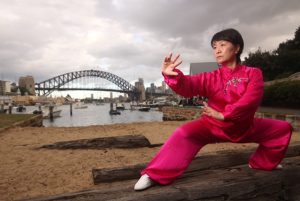What is Bagua Zhang?

Pei Lei Wushu Association provides Bagua classes in Sydney, Australia. Bagua Zhang (Eight Trigram Palm) is part of the internal family of Chinese martial arts which also includes Tai Chi and Xingyi Quan. Like its sister arts, Bagua emphasises relaxation, structure and internal body mechanics over brute strength and pure physicality. Bagua however, is somewhat more physically demanding than Tai Chi, being practiced at a faster pace and involving twisting and spiralling movements that require a greater level of joint mobility and flexibility, however physically able individuals of almost any age will find Bagua greatly enhances their energy levels and overall well-being.
Bagua is generally believed to have been created by Dong Haichuan in the early 19th century. An experienced martial artist, Dong likely combined his wushu knowledge with Yin and Yang theory and Taoist circle walking practice to create Bagua Zhang. Bagua focuses on the concept of change, teaching the practitioner to be able to adept to various situations with speed, flexibility and lateral movement. It’s movements are soft and graceful, driven by unique footwork and spiralling movements of the waist.
There are several sub-styles of Bagua, developed by Dong Haichuan’s students and subsequent generations. They are all based on the same principles but emphasise different mechanics and strategies. Because of this philosophy of Change, Bagua styles and routines tend to be less standardised those in, for example, Tai Chi. However they all hold Circle Walking as a central training method and generally will being training with a selection of 8 techniques or “Mother Palms”, building up to more advanced sequences and “freestyle” practice.
Bagua Classes with Pei Lei Wushu
Master Alice Bei Dong learned Bagua in Shanghai during her time with the Shanghai Wushu Team, competing and performing in many competitions. The style Master Alice teaches in Sydney is known as Round Body Bagua Zhang, derived from Cheng-style Bagua.
Students begin learning basic Circle Walking, followed by the Eight Mother Palms:
1) Single Change Palm
2) Double Change Palm
3) Yielding Palm
4) Turning Back Palm
5) Body Turning Palm
6) Hold the Ball with both Palms
7) Body-Mill Palm
8) Body-Turnover Palm
Students will then be introduced to “freestyle” forms with more advanced techniques, combinations and linking movements. Weapons forms such as the Bagua Dao (Large Broadsword) may follow.

